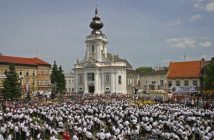Quando in piazza principale nella sua città natale Wadowice Giovanni Paolo II ricordava nel 1999 la gioventù passata lì, nella sua faccia apparve una sincera nostalgia. Queste sensazioni era facile leggerle nel suo volto particolarmente nel momento in cui si ricordò, e anche ai compaesani che riempivano la piazza, che dall’altra sua parte era una volta una pasticceria, dove insieme ai compagni di scuola acquistava un dolce alla crema chiamato kremówka. Era una rivelazione sorprendente, perché papa era conosciuto per la poca importanza che dedicava al cibo. Mangiava semplicemente ciò che gli preparavano le suore cracoviensi, che dall’inizio del suo servizio pastorale da vescovo fino al 2 aprile 2005 si occupavano della sua casa. Chi frequentava la residenza dei vescovi su Via Franciszkańska, invitato a cena dal vescovo Karol Wojtyła, rocorda che i piatti erano molto modesti. “A dire la verità, erano molto misere quelle cenette”, sorride uno dei più importanti cattolici laici del posto. E racconta che in tavolo si portavano a volte semplicemente kaszanka con i krauti saltati in padella, una pietanza molto popolare nelle semplici case polacche che fa parte della tradizionale cucina contadina. Capitava che un ospite poco abituato a tale modestia chiedeva al vescovo di aprire almeno una bottiglia di vino che stava da qualche parte su un altro tavolo, perché il padrone di casa si era dimenticato di uscire con tale iniziativa.
L’abitudine alla semplicità culinare era senz’altro legata all’indigenza vissuta dalla sua famiglia quando era giovane, compresa l’epoca della seconda guerra mondiale. Più tardi, durante ad esempio le sue escursioni turistiche in compagnia agli studenti, Karol Wojtyła si accontentava ugualmente di panini semplici o pranzi preparati con il fornelletto da campeggio. Durante le gite in montagna volentieri capitava nelle capanne dei montanari, dove con piacere si sfamava con formaggi di pecora preparati lì.
Nel Vaticano la situazione cambiò un po’. Le suore del Sacro Cuore di Gesù dovevano considerare nel menu i gusti degli ospiti di papa ormai. Gli cucinavano polacco con un tocco deciso della cucina italiana. Il Cardinale Stanisław Dziwisz, oggi il metropolita di Cracovia, il segretario personale durante tutto il pontificato, ammette che proprio in quei tempi papa apprezzò la pasta.
Capitava tuttavia che le suore polacche portavano a Giovanni Paolo II una zuppa di latte. Quando intravedeva il timore nella faccia dell’ospite lo tranquillizzava: “Anche il papa deve obbedire a qualcuno, perciò io mangio la zuppa, ma a te porteranno una cena normale”.
Dai tempi dei ricordi di Wadowice di Giovanni Paolo II i kremówki, chiamate da quel momento “i kremówki del papa” vivono la rinascita di popolarità. Il dolce di pasta sfoglia ripieno di crema pasticcera alla vaniglia o di budino è il desser preferito di tutti i pellegrini che visitano Wadowice.
L’abitudine alla semplicità culinare era senz’altro legata all’indigenza vissuta dalla sua famiglia quando era giovane, compresa l’epoca della seconda guerra mondiale. Più tardi, durante ad esempio le sue escursioni turistiche in compagnia agli studenti, Karol Wojtyła si accontentava ugualmente di panini semplici o pranzi preparati con il fornelletto da campeggio. Durante le gite in montagna volentieri capitava nelle capanne dei montanari, dove con piacere si sfamava con formaggi di pecora preparati lì.
Nel Vaticano la situazione cambiò un po’. Le suore del Sacro Cuore di Gesù dovevano considerare nel menu i gusti degli ospiti di papa ormai. Gli cucinavano polacco con un tocco deciso della cucina italiana. Il Cardinale Stanisław Dziwisz, oggi il metropolita di Cracovia, il segretario personale durante tutto il pontificato, ammette che proprio in quei tempi papa apprezzò la pasta.
Capitava tuttavia che le suore polacche portavano a Giovanni Paolo II una zuppa di latte. Quando intravedeva il timore nella faccia dell’ospite lo tranquillizzava: “Anche il papa deve obbedire a qualcuno, perciò io mangio la zuppa, ma a te porteranno una cena normale”.
Dai tempi dei ricordi di Wadowice di Giovanni Paolo II i kremówki, chiamate da quel momento “i kremówki del papa” vivono la rinascita di popolarità. Il dolce di pasta sfoglia ripieno di crema pasticcera alla vaniglia o di budino è il desser preferito di tutti i pellegrini che visitano Wadowice.

Vanilla Slices and Simple Black Pudding
In 1999 when John Paul II recalled his childhood years in his native Wadowice, while speaking in the town’s market square, his face displayed real and genuine tenderness. It could especially be seen when he reminded himself, and the residents of Wadowice who filled up the square, that there used to be a cake shop there where he and his friends would go to buy delicious vanilla slices.
It was a surprising confession, because the Pope was known for not attaching much importance to his food. He ate what was prepared by the nuns from Cracow, who ran his household from the very beginning of his Episcopal service until 2nd April, 2005. Those who visited the residence of the Bishops of Cracow on ul. Franciszkańska in Cracow, invited by Bishop Karol Wojtyła for a meal, mention that the food served was very modest. – ‘To put it simply, those meals were meagre’ – smiles an important local lay Catholic, adding that sometimes only, for example, black pudding and fried cabbage were served. This dish, based on peasant cooking traditions, was quite popular in the average Polish home. On occasions a guest, unused to such simplicity, might have to ask the bishop if it was possible to open the bottle of wine left standing on an adjacent table, because such a thought had simply not occurred to the host.
The passion for plain food probably resulted from the difficulties both he and his family experienced in his youth, which included World War II. However, even later, for example, during his trips with students, Karol Wojtyła was usually satisfied with the simple sandwiches and meals that could be prepared on the stove in the hostels in which they stayed. While hiking in the mountains he sometimes stopped at the highland huts scattered across the meadows, where he happily ate the local sheep’s cheese.
In the Vatican the situation had to change somewhat. The Sacred Heart Nuns had to include the preferences of the papal guests on their menu. Although Polish cuisine still dominated, it had a distinctly Italian flavour. The present Archbishop of Cracow and the Pope’s personal secretary throughout his pontificate, Cardinal Stanislaw Dziwisz, admits that it was during those times that he became fond of pasta.
Sometimes, however, John Paul II was served only milk soup by his nuns. When he noticed the concern on his guest’s face he was quick to reassure them, ‘Even the Pope has someone he has to listen to, so I am eating my soup, but you will get a normal dinner.’
Since John Paul II’s recollections of Wadowice’s vanilla slices, now re-named Papal vanilla slices, there has been a renaissance in their popularity. Such chunks of puff pastry filled with vanilla custard is the most frequent choice of dessert for the pilgrims arriving in Wadowice. (b)
It was a surprising confession, because the Pope was known for not attaching much importance to his food. He ate what was prepared by the nuns from Cracow, who ran his household from the very beginning of his Episcopal service until 2nd April, 2005. Those who visited the residence of the Bishops of Cracow on ul. Franciszkańska in Cracow, invited by Bishop Karol Wojtyła for a meal, mention that the food served was very modest. – ‘To put it simply, those meals were meagre’ – smiles an important local lay Catholic, adding that sometimes only, for example, black pudding and fried cabbage were served. This dish, based on peasant cooking traditions, was quite popular in the average Polish home. On occasions a guest, unused to such simplicity, might have to ask the bishop if it was possible to open the bottle of wine left standing on an adjacent table, because such a thought had simply not occurred to the host.
The passion for plain food probably resulted from the difficulties both he and his family experienced in his youth, which included World War II. However, even later, for example, during his trips with students, Karol Wojtyła was usually satisfied with the simple sandwiches and meals that could be prepared on the stove in the hostels in which they stayed. While hiking in the mountains he sometimes stopped at the highland huts scattered across the meadows, where he happily ate the local sheep’s cheese.
In the Vatican the situation had to change somewhat. The Sacred Heart Nuns had to include the preferences of the papal guests on their menu. Although Polish cuisine still dominated, it had a distinctly Italian flavour. The present Archbishop of Cracow and the Pope’s personal secretary throughout his pontificate, Cardinal Stanislaw Dziwisz, admits that it was during those times that he became fond of pasta.
Sometimes, however, John Paul II was served only milk soup by his nuns. When he noticed the concern on his guest’s face he was quick to reassure them, ‘Even the Pope has someone he has to listen to, so I am eating my soup, but you will get a normal dinner.’
Since John Paul II’s recollections of Wadowice’s vanilla slices, now re-named Papal vanilla slices, there has been a renaissance in their popularity. Such chunks of puff pastry filled with vanilla custard is the most frequent choice of dessert for the pilgrims arriving in Wadowice. (b)










